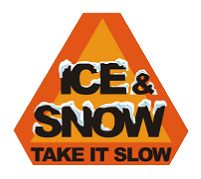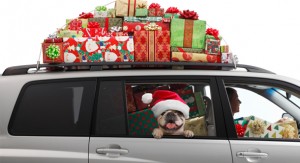 Whether you’re traveling across town or around the world, help ensure your trip is safe. Don’t drink and drive, and don’t let someone else drink and drive. Wear a seat belt every time you drive or ride in a motor vehicle. Always buckle your child in the car using a child safety seat, booster seat, or seat belt appropriate for his/her height, weight, and age.
Whether you’re traveling across town or around the world, help ensure your trip is safe. Don’t drink and drive, and don’t let someone else drink and drive. Wear a seat belt every time you drive or ride in a motor vehicle. Always buckle your child in the car using a child safety seat, booster seat, or seat belt appropriate for his/her height, weight, and age.
Category: Safety on the Road
Winter Driving Safety Tips
The best advice for driving in bad winter weather is not to drive at all, if you can avoid it.
Don’t go out until the snow plows and sanding trucks have had a chance to do their work, and allow yourself extra time to reach your destination.
If you must drive in snowy conditions, make sure your car is prepared, and that you know how to handle road conditions.
It’s helpful to practice winter driving techniques in a snowy, open parking lot, so you’re familiar with how your car handles. Consult your owner’s manual for tips specific to your vehicle.
Driving safely on icy roads
- Decrease your speed and leave yourself plenty of room to stop. You should allow at least three times more space than usual between you and the car in front of you.
- Brake gently to avoid skidding. If your wheels start to lock up, ease off the brake.
- Turn on your lights to increase your visibility to other motorists.
- Keep your lights and windshield clean.
- Use low gears to keep traction, especially on hills.
- Don’t use cruise control or overdrive on icy roads.
- Be especially careful on bridges, overpasses and infrequently traveled roads, which will freeze first. Even at temperatures above freezing, if the conditions are wet, you might encounter ice in shady areas or on exposed roadways like bridges.
- Don’t pass snow plows and sanding trucks. The drivers have limited visibility, and you’re likely to find the road in front of them worse than the road behind.
- Don’t assume your vehicle can handle all conditions. Even four-wheel and front-wheel drive vehicles can encounter trouble on winter roads.
via weather.com – Driving Safety Tips – Driving in Snow and Ice.
Autumn Driving Safety Tips
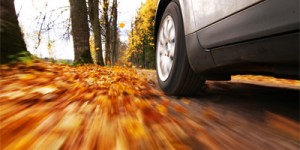 Make adjustments for the light. Did you know that we lose a minute of daylight every day until the clocks are set back in November? Fewer hours of daylight make it more difficult to see pedestrians, cyclists and children playing in the late afternoon. Also, later sunrises mean that drivers need to adjust to the brighter sun at different times of the morning. Always keep a pair of sunglasses in your car to shield your vision.
Make adjustments for the light. Did you know that we lose a minute of daylight every day until the clocks are set back in November? Fewer hours of daylight make it more difficult to see pedestrians, cyclists and children playing in the late afternoon. Also, later sunrises mean that drivers need to adjust to the brighter sun at different times of the morning. Always keep a pair of sunglasses in your car to shield your vision.- Avoid driving over wet leaves. Fall foliage is beautiful but once those leaves start falling and get wet from rain, they can become a serious driving hazard. Wet leaves are slippery and reduce traction.
- Don’t Veer for Deer. If a crash with a deer is unavoidable, remember don’t swerve. Be sure to brake firmly and hold onto the steering wheel with both hands. Come to a controlled stop and move the vehicle out of traffic to a safe location.
- Prepare an emergency kit for your car. Carrying an emergency kit in your car trunk or cargo area can be a real lifesaver. Be sure to include a flashlight, flares and a first-aid kit, jumper cables, extra washer fluid, nonperishable food, a jug of water, and a few basic tools such as wrenches, a ratchet/socket set, screwdrivers, and pliers.
- Watch for frost. Low nighttime temperatures cause frost on windshields and roads. Be sure to clear your windshield completely before driving. Also, slow down when approaching bridges and overpasses, as these structures are more prone to collect frost on the roadway surface. Stay alert for shaded areas that could create black ice during early morning and evening hours.
- Plan ahead for changing weather conditions. Have your car winterized before the winter storm season sets in. Keeping your car in good condition decreases your chance of being stranded in cold weather. Also, be sure to have a first-aid kit, thermal blanket, a working flashlight, a shovel and sand in your car.
- Watch for construction work zones. Construction work zones may still be active. Consult MDOT’s Mi Drive traffic Web site to plan your route. Please remember to slow down and pay attention in work zones. The life you save could be your own.
Distracted Driving
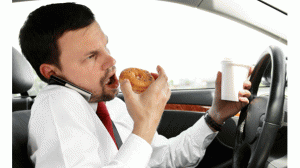 Each day in the United States, more than 9 people are killed and more than 1,060 people are injured in crashes that are reported to involve a distracted driver. Distracted driving is driving while doing another activity that takes your attention away from driving. Distracted driving can increase the chance of a motor vehicle crash.
Each day in the United States, more than 9 people are killed and more than 1,060 people are injured in crashes that are reported to involve a distracted driver. Distracted driving is driving while doing another activity that takes your attention away from driving. Distracted driving can increase the chance of a motor vehicle crash.
There are three main types of distraction:
- Visual: taking your eyes off the road.
- Manual: taking your hands off the wheel.
- Cognitive: taking your mind off of driving.
Distracted driving activities include things like using a cell phone, texting, and eating. Using in-vehicle technologies such as navigation systems can also be sources of distraction. While any of these distractions can endanger the driver and others, texting while driving is especially dangerous because it combines all three types of distraction.
via CDC – Distracted Driving – Motor Vehicle Safety – Injury Center.
Distracted Driving
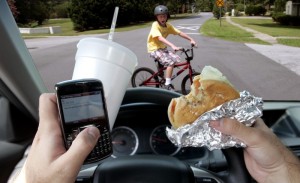 Each day in the United States, more than 9 people are killed and more than 1,060 people are injured in crashes that are reported to involve a distracted driver. Distracted driving is driving while doing another activity that takes your attention away from driving. Distracted driving can increase the chance of a motor vehicle crash.
Each day in the United States, more than 9 people are killed and more than 1,060 people are injured in crashes that are reported to involve a distracted driver. Distracted driving is driving while doing another activity that takes your attention away from driving. Distracted driving can increase the chance of a motor vehicle crash.
There are three main types of distraction:
- Visual: taking your eyes off the road.
- Manual: taking your hands off the wheel.
- Cognitive: taking your mind off of driving.
Distracted driving activities include things like using a cell phone, texting, and eating. Using in-vehicle technologies (such as navigation systems) can also be sources of distraction. While any of these distractions can endanger the driver and others, texting while driving is especially dangerous because it combines all three types of distraction.
via CDC – Distracted Driving – Motor Vehicle Safety – Injury Center.
Harvest-Time Danger
 It’s harvest time and with it comes unique dangers. Here is a list of a few to consider:
It’s harvest time and with it comes unique dangers. Here is a list of a few to consider:
*Regular inhalation of dust from grain bins, silos, milk vats and manure pits can cause respiratory issues such as bronchitis and other dangerous cardiac conditions. Wearing a mask over your nose and mouth can reduce risk.
*Farm vehicles such as tractors and all-terrain vehicles cause many injuries, particularly among children. Wearing a seat belt and helmet can help prevent traumatic brain injuries or even death. Children should be supervised and given only age-appropriate tasks and access to vehicles and other farm gear.
*Grain augers are one of the most dangerous pieces of farm equipment. Broken bones, electrocutions and amputations can occur if augers aren’t handled properly.
*Livestock is another common source of injury. Cattle and other farm animals can bite, kick, ram or trample someone without warning. Stay attentive and alert.
*Working long days and evenings in the field can cause dangerous levels of fatigue. Farmers may experience shortness of breath, stroke or heart attack. Try to take breaks, eat a healthy diet and get plenty of sleep.
*Only enter a grain bin or gravity wagon when absolutely necessary, especially when grain is flowing. You can quickly become trapped and suffocate. If you must enter a grain bin, use a body harness and safety line secured outside the bin, and always have someone watching in case you are entrapped.
*Take special care to avoid falls, another common farm injury and the source of not only broken bones, but head injuries and other physical trauma.
*Protect eyes from debris whipped up by farm machinery.
An additional tip, one that applies to non-farmers as well: Please be extra cautious driving near farm machinery on the roadways, farm vehicles need to travel slowly on occasion so give them a break.
via Mayo Clinic – Harvest-Time Danger: Mayo Clinic Expert Discusses Common Farm Injuries.
Eight Secrets of Super Driving
 When you drive defensively, you’re aware and ready for whatever happens. You are cautious, yet ready to take action and not put your fate in the hands of other drivers. According to the U.S. Department of Transportation, 90% of all crashes are attributed to driver error.
When you drive defensively, you’re aware and ready for whatever happens. You are cautious, yet ready to take action and not put your fate in the hands of other drivers. According to the U.S. Department of Transportation, 90% of all crashes are attributed to driver error.
Following these defensive driving tips can help reduce your risk behind the wheel:
- Think safety first. Avoiding aggressive and inattentive driving tendencies yourself will put you in a stronger position to deal with other people’s bad driving. Leave plenty of space between you and the car in front. Always lock your doors and wear your seatbelt to protect you from being thrown from the car in a crash.
- Be aware of your surroundings — pay attention. Check your mirrors frequently and scan conditions 20 to 30 seconds ahead of you. Keep your eyes moving. If a vehicle is showing signs of aggressive driving, slow down or pull over to avoid it. If the driver is driving so dangerously that you’re worried, try to get off the roadway by turning right or taking the next exit if it’s safe to do so. Also, keep an eye on pedestrians, bicyclists, and pets along the road.
- Do not depend on other drivers. Be considerate of others but look out for yourself. Do not assume another driver is going to move out of the way or allow you to merge. Assume that drivers will run through red lights or stop signs and be prepared to react. Plan your movements anticipating the worst-case scenario.
- Have an escape route. In all driving situations, the best way to avoid potential dangers is to position your vehicle where you have the best chance of seeing and being seen. Having an alternate path of travel is essential, so take the position of other vehicles into consideration when determining an alternate path of travel. Always leave yourself an out — a place to move your vehicle if your immediate path of travel was suddenly blocked.
- Follow the 3- to 4-second rule. Since the greatest chance of a collision is in front of you, using the 3- to 4-second rule will help you establish and maintain a safe following distance and provide adequate time for you to brake to a stop if necessary. But this rule only works in normal traffic under good weather conditions. In bad weather, increase your following distance an additional second for each condition such as rain, fog, nighttime driving, or following a large truck or motorcycle.
- Keep your speed down. Posted speed limits apply to ideal conditions. It’s your responsibility to ensure that your speed matches conditions. In addition, higher speeds make controlling your vehicle that much more difficult if things go wrong. To maintain control of your vehicle, you must control your speed.
- Separate risks. When faced with multiple risks, it’s best to manage them one at a time. Your goal is to avoid having to deal with too many risks at the same time.
- Cut out distractions. A distraction is any activity that diverts your attention from the task of driving. Driving deserves your full attention — so stay focused on the driving task.
School Buses and Child Safety Tips
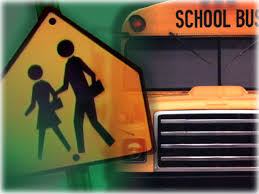 With the start of the new school year motorists should also re-familiarize themselves with the yellow school buses and changes in traffic flow and speed they bring. Drivers should be on the watch for school buses and know school bus safety rules. Parents of young drivers, especially those driving themselves to school for perhaps the first time this school year, should review the rules and warnings with family members. Those big yellow buses transport our most precious commodity–our children–and bus drivers report that motorists need reminders about do’s and don’t’s around school buses every fall. After all, motorists will be sharing the road with school buses during the hectic morning commute.
With the start of the new school year motorists should also re-familiarize themselves with the yellow school buses and changes in traffic flow and speed they bring. Drivers should be on the watch for school buses and know school bus safety rules. Parents of young drivers, especially those driving themselves to school for perhaps the first time this school year, should review the rules and warnings with family members. Those big yellow buses transport our most precious commodity–our children–and bus drivers report that motorists need reminders about do’s and don’t’s around school buses every fall. After all, motorists will be sharing the road with school buses during the hectic morning commute.
Building the Business Case for Behavioral Safety
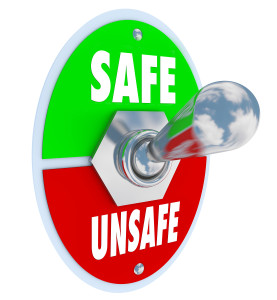 How do you sell a behavioral safety program to management? Keep these few pointers in mind.
How do you sell a behavioral safety program to management? Keep these few pointers in mind.
- Partner with someone in Accounting or Finance to build the financial case for implementing a behavioral safety program. Use the terminology of investment.
- Stress behavioral safety is an investment, not a cost. Show how the commitment of resources can earn the company financial returns or gain future benefits or advantages.
- To help with number two, get current/past cost data on workers’ compensation and follow the ROI guidelines of your organization. Project investment returns by using direct and indirect costs.
- Stress that behavioral safety helps contribute to fewer lost time incidents and workers’ compensation (WC) claims, lower WC premiums and admin costs, higher employee morale, a better reputation and more.
Back-to-School Safety
 When summer comes to an end, children get ready to go back to school. This is a great time for parents to talk to their kids about how to safely travel to and from school. Following a few safety tips can help prevent children from suffering serious injuries.
When summer comes to an end, children get ready to go back to school. This is a great time for parents to talk to their kids about how to safely travel to and from school. Following a few safety tips can help prevent children from suffering serious injuries.
School Bus Safety Tips
- Children riding the bus to school should learn and practice a few safety rules for getting on and off the bus.
- Get to the bus stop early. Do not run to the bus.
- Wait until the bus has come to a complete stop before walking toward it.
- If crossing the street, wait for a signal from the bus driver. Look both ways to make sure there is no moving traffic from either direction.
- Always cross in front of the bus so the driver can see you.
- If the bus has lap and shoulder belts, use them.
- Once the bus is in motion, remain in your seat.
- If the window is open, keep your arms and head inside the bus at all times.
- Do not stand up to get off the bus until it has completely stopped.
- Only get off the bus at your assigned spot.
Walking Safety Tips
- Children should only walk to school alone if they are old enough and ready to make the walk safely.
- Children are not ready to walk to school without an adult until they are at least 10 years old.
- Younger kids cannot be trusted to make smart traffic choices on their own.
- Plan and practice a safe walking route with your child until she knows it well.
- Use streets with sidewalks, crosswalks and crossing guards. Avoid as many intersections as possible.
- Have children walk with a friend or in a group.
- Talk to your child about what to do if they are approached by a stranger.
Safety Tips for Drivers
- Drivers should be aware of children walking to school or to the bus stop. Everyone can follow a few safety tips to help kids get to school safely.
- When backing out of the driveway, watch for children walking to school or to a bus stop.
- On streets without crossing guards, watch out for children trying to cross the street.
- Be careful on streets without sidewalks or streets with on-street parking. It might be hard to notice a child behind a car.
- Be alert. Children may dart into the street without looking.
- Slow down.
via Injury Research and Policy Back-to-School Safety :: Nationwide Children’s Hospital, Columbus, Ohio.

